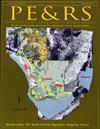基于线段局部区域约束的地空图像特征点匹配
IF 2
4区 地球科学
Q4 GEOGRAPHY, PHYSICAL
引用次数: 1
摘要
在本研究中,我们提出了一种对视点、尺度和光照变化具有鲁棒性的地空图像特征点匹配方法,以提高匹配性能。首先,采用三维渲染策略,将航拍图像重建的三维网格模型合成地面图像,克服航拍图像与地面图像之间的全局几何畸变;我们不直接匹配合成图像与地面图像之间的特征点,而是通过设计一种适应合成图像局部几何变形、孔洞和模糊纹理的线段匹配方法提取线段对应关系。然后,在线段匹配的基础上,构造局部区域对应关系,将合成图像上的局部区域传播回原始航拍图像。最后,在局部区域对应约束下,对地空图像进行特征点匹配。实验结果表明,与现有方法相比,该方法能够获得更高的匹配正确率和匹配精度。具体而言,该方法将次优方法的平均正确匹配次数和平均匹配精度分别提高了5倍以上和40%。本文章由计算机程序翻译,如有差异,请以英文原文为准。
Feature-Point Matching for Aerial and Ground Images by Exploiting Line Segment-Based Local-Region Constraints
In this study, we propose a feature-point matching method that is robust to viewpoint, scale, and illumination changes between aerial and ground images, to improve matching performance. First, a 3D rendering strategy is adopted to synthesize ground-view images from the 3D mesh model
reconstructed from aerial images and overcome the global geometric distortion between aerial and ground images. We do not directly match feature points between the synthesized and ground images, but extract line-segment correspondences by designing a line-segment matching method that can adapt
to the local geometric deformation, holes, and blurred textures on the synthesized image. Then, on the basis of the line-segment matches, local-region correspondences are constructed, and local regions on the synthesized image are propagated back to the original aerial images. Lastly, feature-point
matching is performed between the aerial and ground images with the constraints of the local-region correspondences. Experimental results demonstrate that the proposed method can obtain more correct matches and higher matching precision than state-of-the-art methods. Specifically, the proposed
method increases the average number of correct matches and average matching precision of the second-best method by more than five times and 40%, respectively.
求助全文
通过发布文献求助,成功后即可免费获取论文全文。
去求助
来源期刊

Photogrammetric Engineering and Remote Sensing
地学-成像科学与照相技术
CiteScore
1.70
自引率
15.40%
发文量
89
审稿时长
9 months
期刊介绍:
Photogrammetric Engineering & Remote Sensing commonly referred to as PE&RS, is the official journal of imaging and geospatial information science and technology. Included in the journal on a regular basis are highlight articles such as the popular columns “Grids & Datums” and “Mapping Matters” and peer reviewed technical papers.
We publish thousands of documents, reports, codes, and informational articles in and about the industries relating to Geospatial Sciences, Remote Sensing, Photogrammetry and other imaging sciences.
 求助内容:
求助内容: 应助结果提醒方式:
应助结果提醒方式:


